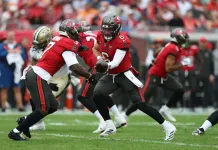Super Bowl prop bet history
As a graphic designer, I’ve created and seen some amazing publications over the last 20 years, including our annual VSiN guides. In my eyes, however, there is nothing more majestic than witnessing the minty green, licorice red and natural white lights strewn about a cavernous black odds board in a sportsbook. There are only a few other places in the world I’d rather be.
If you are still with me after that first paragraph, it means you were able to ignore the spine-tingling sensation that caused you to consider why you are reading a handicapping article from a graphic designer. Well, my friend, thanks for sticking around. I can assure you that while the next 10 minutes will not be the most exhilarating of your day, I do guarantee you’ll pick up at least one nugget you never knew before. The first: by day, I am a designer, but by night, I morph into a stat nerd.
Anyhow, without further ado, welcome to Matty’s 6th Annual Big Game Prop-a-Rating-Palooza! Yea, yea… I know I should stick to the design elements for VSiN, but the ever-changing and not-so-clever title will start to grow on you.
So, what is the Big Game Prop-a-Rating-Palooza? I’m glad you asked. Back in 2019, for Super Bowl LIII, I started a deep-dive into the historical outcome of props for all of the Big Games dating back to 2002. Beyond determining win-loss records for over 150 props at the time, I also came up with a value that I decided to call the ‘exceptional rating’. Original, right? Remember, I’m a graphic designer, not a writer.
In short, the ‘exceptional rating’ is nothing more than a way to try and quantify the value of a prop’s betting line, and as a result, the advantage a bettor might have in placing a bet on that prop. How do you calculate the ‘exceptional rating’? I’ll get to that in a minute.
First, I should note that in the past, this article hasn’t come out until the props have been released by sportsbooks, roughly a week after the AFC and NFC Championship games. This year, I thought I’d try something a bit different, which is to supply the records for over 200 historical Super Bowl props before they are released for this year’s big game. The goal for releasing the data in advance is that I hope it will provide you with an early window to take advantage of the ‘exceptional rating’ some of the props will have before the market completely reshapes some of the lines.
After reviewing nearly 300 props for Super Bowl LVIII, in last season’s article, which included 17 props with an ‘exceptional rating’, I finished with a 10-7 record, down just 0.55 units. Five seasons into this adventure, my record is 51-20 (71.8%, +21.15 units).
So, how do I calculate ‘exceptional rating’? Let’s have a look together:
Step 1: Using an odds converter, I determine the implied odds of a prop based on the percentage of times the outcome has been correct or incorrect.
Step 2: I then determine the difference in the odds listed for the prop in the sportsbook and the implied odds calculated in Step 1.
For example:
The team that has scored last has won the Super Bowl in 20 of the last 22 games, or 90.91% of the time. Using the odds converter, this translates to implied odds of -1000. This means I would expect to walk into a sportsbook and lay 10 units to win one unit that the team with the final score wins the Big Game. When I reach the sportsbook, I see that I actually need to lay only 2.3 units, or moneyline odds of -230, to win one unit, and I’ve saved 7.7 units from what I expected to have to wager. This allows me to determine my rating, by taking my -1000 implied odds and subtracting the sportsbook’s moneyline odds of -230, giving me an exceptional rating of 770.
In addition to determining an exceptional rating for each prop, I also set a minimum exceptional rating (kind of like a baseline) for a prop to be considered for a wager. The last three years I’ve set that minimum at an exceptional rating of greater than 500 (the prior two years the value was 400). Setting a minimum exceptional rating helps ensure that I am responsible with my selections by not betting every prop on the board.
As you review the props, keep a couple of things in mind:
- The vast majority of these props will be available at several books. Take your time and do some homework. Be sure to shop around and find the shop that has the best odds for the side of the prop you are looking to bet.
- Some books might write props a bit differently from what I’ve captured, but they are actually the same in the end. For example, one book might write: “What will be the first offensive play of the second half? Pass -110 or Run -110?” Another book might write: “Will the first play of the second half be a pass? Yes -110 or No -110?”
- Should you bet props that are calculated below the minimum exceptional rating of 500? That is entirely up to you. The exceptional rating you might apply to your props should just be one weapon in your arsenal against the books. Consider the tendencies of the teams playing throughout the season as well as advice from VSiN personalities, writers and guests when placing your bets. There will be plenty of great bets available that fall below my minimum exceptional value of 500.
- There will be some props with an exceptional value above 500 that will carry an extremely high line (ex: -1800). Consider wagering on these props as you are able while staying within your bankroll.
When it comes to making your bets, keep an open mind and let the numbers, data and research be your guide. Bottom line, enjoy the big game and good luck! And if you find yourself in a sportsbook, take a moment to enjoy the greens, reds and whites on the big, black board.
TOP TRENDS
Below is a list of the top props based on win/loss percentage over the last 22 Super Bowls. Click here for a full list of prop records and instructions for determining an ‘exceptional rating’ as props are released in the next few days.
| Prop | Yes | No | % Yes | % No | TIE or N/A |
| Any player 200+ receiving yards | 0 | 22 | 0.00% | 100.00% | |
| Longest FG in game Over 54.5 | 0 | 22 | 0.00% | 100.00% | |
| Fumble opponent’s end zone and touchback | 0 | 22 | 0.00% | 100.00% | |
| 1st play sack | 0 | 22 | 0.00% | 100.00% | |
| 1st play TD | 0 | 22 | 0.00% | 100.00% | |
| Punt return for Touchdown (does not include block return) | 0 | 22 | 0.00% | 100.00% | |
| Each team to have a touchdown and field goal in each half | 0 | 22 | 0.00% | 100.00% | |
| Any player scores 8 points in single drive | 1 | 21 | 4.55% | 95.45% | |
| Will there be overtime | 1 | 21 | 4.55% | 95.45% | |
| Teams combine for more than 900 total yards | 1 | 21 | 4.55% | 95.45% | |
| Any player 150+ receiving yards | 1 | 21 | 4.55% | 95.45% | |
| Will a QB have a reception | 1 | 21 | 4.55% | 95.45% | |
| 1st play turnover | 1 | 21 | 4.55% | 95.45% | |
| Both teams score 35+ points | 1 | 21 | 4.55% | 95.45% | |
| Punt blocked | 1 | 21 | 4.55% | 95.45% | |
| Offensive touchdown scored on 4th down | 1 | 21 | 4.55% | 95.45% | |
| Successful onside kick | 1 | 21 | 4.55% | 95.45% | |
| Shortest TD Under 3.5 yards | 21 | 1 | 95.45% | 4.55% |








